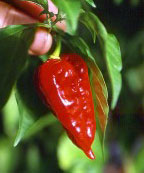Who Will Be The Next
World Champion?
Order: Dried Chiles Chile Powders Hot Pepper Seeds
Will the next, world's heat champion, be found in some remote jungle,
a local food market or maybe be created in a science lab by genetic
research? Who knows? Only time will tell. One thing is for sure, it will
be found! Records are made to be broken.
Contenders and Challengers
Naga Jolokia (Tezpur)
The Indians claimed to have developed a hotter variety than the Red
Savina Habanero, the Naga Jolokia (also called Tezpur and Nagahari),
but tests to date have proved inconclusive.
However, it could be the same chile described in an article printed in
the journal Current Scientist on 8/10/2000). In it, scientists
from Tezpur (a town in the north eastern Indian state of Assam),
claimed to have found a local chile that measured 855,000 SHU when
tested by HPLC (high pressure liquid chromatography). They identified
the chile as being a Tezpur variety called "Nagahari", which they said
is a Capsicum frutescens.
The results were debunked by Dave Dewitt, an acknowledged expert on
chiles who manages a email newsletter called Fiery-Foods.com. Dave
put forward a convincing argument that explained why the heat level was
suspect.
Before testing the heat level of the "Dorset Naga" we agreed with Dave,
and hadn't given much credence to the Indian claim. In light of the
results, however, we now have second thoughts. Perhaps the heat levels the
Indian scientists reported are genuine, and possibly their "Nagahari" and
the "Dorset Naga/Naga Morich" are the same chile.
Dorset Naga
News Article: Telegraph Group Limited.
Written By: Richard Savill 1/4/06
A chile pepper grown in a poly-tunnel in Dorset has been claimed as the
world's hottest. The Dorset Naga is so fiery that when the owners break the
skin to remove the seeds to sow for the following year's crop they have to
wear gloves and be outside in a strong wind so their eyes don't sting.
"It is something I wouldn't eat but some people must like them," said Joy
Michaud, who developed the chile at the Peppers by Post business she runs
with her husband Michael at West Bexington.
An American laboratory found the chile to be almost 60 per cent hotter
than the one listed in the "Guinness
Book of Records". The Naga registered a Scoville heat unit of 876,000.
The record holder is a Red Savina Habanero with a rating of 577,000.
The result was so startling that the Dorset pepper was sent for a second
test to a laboratory in New York used by the American Spice Trade
Association. It recorded a higher figure of 970,000 heat units. The Naga,
which is sold with a health warning, was developed from a variety which
originated in Bangladesh.
The Michauds found the chiles, collected the seeds and grew them. It was
only when customers told them they were unable to eat curries containing
half a small pepper that they realized how hot they were.
Mrs Michaud said: "We bought the Naga Morich chile from a shop in
Bournemouth. It is revered by the Bangladeshis. We have all the
certificates and believe it is a world record. We will be in touch with the
Guinness Book of Records".
Aktar Miha, of the Indis Bangladeshi restaurant in Bournemouth, said: "Most
people don't cook with it; they just have it near to them when they eat.
They just touch their food with it. If you don't know what you are doing it
could blow your head off.